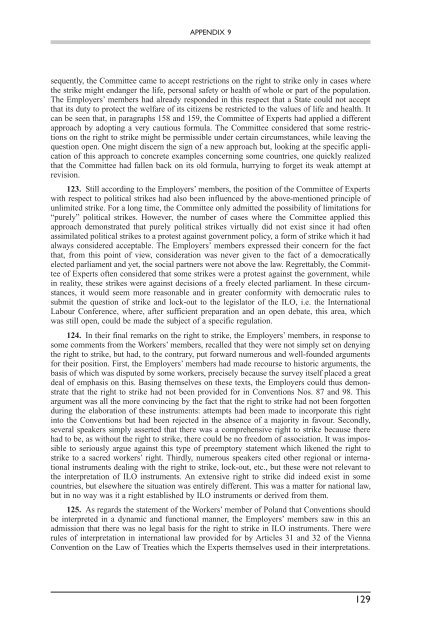Employers' Handbook on ILO Standards-related Activities
Employers' Handbook on ILO Standards-related Activities
Employers' Handbook on ILO Standards-related Activities
You also want an ePaper? Increase the reach of your titles
YUMPU automatically turns print PDFs into web optimized ePapers that Google loves.
APPENDIX 9<br />
sequently, the Committee came to accept restricti<strong>on</strong>s <strong>on</strong> the right to strike <strong>on</strong>ly in cases where<br />
the strike might endanger the life, pers<strong>on</strong>al safety or health of whole or part of the populati<strong>on</strong>.<br />
The Employers’ members had already resp<strong>on</strong>ded in this respect that a State could not accept<br />
that its duty to protect the welfare of its citizens be restricted to the values of life and health. It<br />
can be seen that, in paragraphs 158 and 159, the Committee of Experts had applied a different<br />
approach by adopting a very cautious formula. The Committee c<strong>on</strong>sidered that some restricti<strong>on</strong>s<br />
<strong>on</strong> the right to strike might be permissible under certain circumstances, while leaving the<br />
questi<strong>on</strong> open. One might discern the sign of a new approach but, looking at the specific applicati<strong>on</strong><br />
of this approach to c<strong>on</strong>crete examples c<strong>on</strong>cerning some countries, <strong>on</strong>e quickly realized<br />
that the Committee had fallen back <strong>on</strong> its old formula, hurrying to forget its weak attempt at<br />
revisi<strong>on</strong>.<br />
123. Still according to the Employers’ members, the positi<strong>on</strong> of the Committee of Experts<br />
with respect to political strikes had also been influenced by the above-menti<strong>on</strong>ed principle of<br />
unlimited strike. For a l<strong>on</strong>g time, the Committee <strong>on</strong>ly admitted the possibility of limitati<strong>on</strong>s for<br />
“purely” political strikes. However, the number of cases where the Committee applied this<br />
approach dem<strong>on</strong>strated that purely political strikes virtually did not exist since it had often<br />
assimilated political strikes to a protest against government policy, a form of strike which it had<br />
always c<strong>on</strong>sidered acceptable. The Employers’ members expressed their c<strong>on</strong>cern for the fact<br />
that, from this point of view, c<strong>on</strong>siderati<strong>on</strong> was never given to the fact of a democratically<br />
elected parliament and yet, the social partners were not above the law. Regrettably, the Committee<br />
of Experts often c<strong>on</strong>sidered that some strikes were a protest against the government, while<br />
in reality, these strikes were against decisi<strong>on</strong>s of a freely elected parliament. In these circumstances,<br />
it would seem more reas<strong>on</strong>able and in greater c<strong>on</strong>formity with democratic rules to<br />
submit the questi<strong>on</strong> of strike and lock-out to the legislator of the <strong>ILO</strong>, i.e. the Internati<strong>on</strong>al<br />
Labour C<strong>on</strong>ference, where, after sufficient preparati<strong>on</strong> and an open debate, this area, which<br />
was still open, could be made the subject of a specific regulati<strong>on</strong>.<br />
124. In their final remarks <strong>on</strong> the right to strike, the Employers’ members, in resp<strong>on</strong>se to<br />
some comments from the Workers’ members, recalled that they were not simply set <strong>on</strong> denying<br />
the right to strike, but had, to the c<strong>on</strong>trary, put forward numerous and well-founded arguments<br />
for their positi<strong>on</strong>. First, the Employers’ members had made recourse to historic arguments, the<br />
basis of which was disputed by some workers, precisely because the survey itself placed a great<br />
deal of emphasis <strong>on</strong> this. Basing themselves <strong>on</strong> these texts, the Employers could thus dem<strong>on</strong>strate<br />
that the right to strike had not been provided for in C<strong>on</strong>venti<strong>on</strong>s Nos. 87 and 98. This<br />
argument was all the more c<strong>on</strong>vincing by the fact that the right to strike had not been forgotten<br />
during the elaborati<strong>on</strong> of these instruments: attempts had been made to incorporate this right<br />
into the C<strong>on</strong>venti<strong>on</strong>s but had been rejected in the absence of a majority in favour. Sec<strong>on</strong>dly,<br />
several speakers simply asserted that there was a comprehensive right to strike because there<br />
had to be, as without the right to strike, there could be no freedom of associati<strong>on</strong>. It was impossible<br />
to seriously argue against this type of preemptory statement which likened the right to<br />
strike to a sacred workers’ right. Thirdly, numerous speakers cited other regi<strong>on</strong>al or internati<strong>on</strong>al<br />
instruments dealing with the right to strike, lock-out, etc., but these were not relevant to<br />
the interpretati<strong>on</strong> of <strong>ILO</strong> instruments. An extensive right to strike did indeed exist in some<br />
countries, but elsewhere the situati<strong>on</strong> was entirely different. This was a matter for nati<strong>on</strong>al law,<br />
but in no way was it a right established by <strong>ILO</strong> instruments or derived from them.<br />
125. As regards the statement of the Workers’ member of Poland that C<strong>on</strong>venti<strong>on</strong>s should<br />
be interpreted in a dynamic and functi<strong>on</strong>al manner, the Employers’ members saw in this an<br />
admissi<strong>on</strong> that there was no legal basis for the right to strike in <strong>ILO</strong> instruments. There were<br />
rules of interpretati<strong>on</strong> in internati<strong>on</strong>al law provided for by Articles 31 and 32 of the Vienna<br />
C<strong>on</strong>venti<strong>on</strong> <strong>on</strong> the Law of Treaties which the Experts themselves used in their interpretati<strong>on</strong>s.<br />
129

















